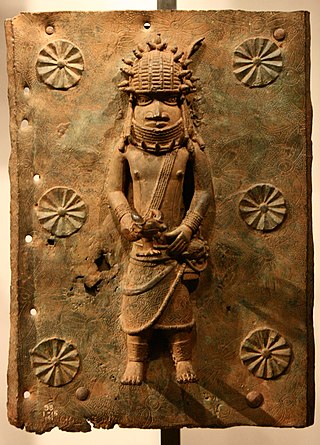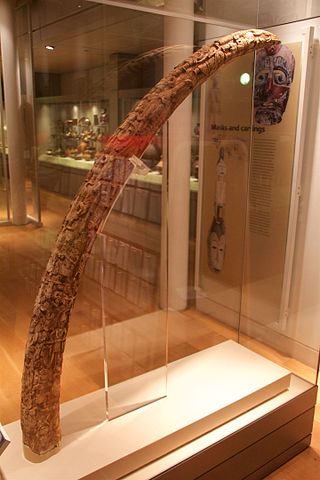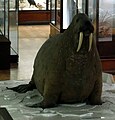
Pitt Rivers Museum is a museum displaying the archaeological and anthropological collections of the University of Oxford in England. The museum is located to the east of the Oxford University Museum of Natural History, and can only be accessed through that building.

The Benin Bronzes are a group of several thousand metal plaques and sculptures that decorated the royal palace of the Kingdom of Benin, in what is now Edo State, Nigeria. Collectively, the objects form the best examples of Benin art and were created from the thirteenth century by artists of the Edo people. The plaques, which in the Edo language are called Ama, depict scenes or represent themes in the history of the kingdom. Apart from the plaques, other sculptures in brass or bronze include portrait heads, jewelry, and smaller pieces.

Forest Hill is a district of the London Borough of Lewisham in south east London, England, on the South Circular Road, which is home to the Horniman Museum.

Coombe is a place in the London Borough of Croydon, situated south-east of central Croydon, between Addiscombe, Selsdon and Upper Shirley. Formerly a hamlet, since the growth of suburban development the area has become swallowed into the London conurbation and often does not appear on modern map.

Syon House is the west London residence of the Duke of Northumberland. A Grade I listed building, it lies within the 200-acre Syon Park, in the London Borough of Hounslow.

Bishopsgate Institute is a cultural institute in the Bishopsgate Without area of the City of London, located near Liverpool Street station and Spitalfields market. The institute was established in 1895. It offers a cultural events programme, courses for adults, historic library and archive collections and community programme.

Repatriation is the return of the cultural property, often referring to ancient or looted art, to their country of origin or former owners.

The Musée du Quai Branly – Jacques Chirac, located in Paris, France, is a museum designed by French architect Jean Nouvel to feature the indigenous art and cultures of Africa, Asia, Oceania, and the Americas. The museum collection comprises more than a million objects, of which 3,500 are on display at any given time, in both permanent and temporary thematic exhibits. A selection of objects from the museum is also displayed in the Pavillon des Sessions of the Louvre.

The Museum of Archaeology and Anthropology, also known as MAA, at the University of Cambridge houses the university's collections of local antiquities, together with archaeological and ethnographic artefacts from around the world. The museum is located on the university's Downing Site, on the corner of Downing Street and Tennis Court Road. In 2013 it reopened following a major refurbishment of the exhibition galleries, with a new public entrance directly on to Downing Street.

Benin art is the art from the Kingdom of Benin or Edo Empire (1440–1897), a pre-colonial African state located in what is now known as the Southern region of Nigeria. Primarily made of cast bronze and carved ivory, Benin art was produced mainly for the court of the Oba of Benin – a divine ruler for whom the craftsmen produced a range of ceremonially significant objects. The full complexity of these works can be appreciated through the awareness and consideration of two complementary cultural perceptions of the art of Benin: the Western appreciation of them primarily as works of art, and their understanding in Benin as historical documents and as mnemonic devices to reconstruct history, or as ritual objects. This original significance is of great importance in Benin.
Charles Harrison Townsend was an English architect. He was born in Birkenhead, educated at Birkenhead School and articled to the Liverpool architect Walter Scott in 1870. He moved to London with his family in 1880 and entered partnership with the London architect Thomas Lewis Banks in 1884. Townsend became a member of the Art Workers' Guild in 1888 and in the same year was elected a Fellow of the more conservative Royal Institute of British Architects. He remained an active member of both organisations throughout his career and was elected Master of the Art Workers' Guild in 1903. He is important Modern Style architect whose favourite motif was the tree.

Kew Gardens is a botanic garden in southwest London that houses the "largest and most diverse botanical and mycological collections in the world". Founded in 1840, from the exotic garden at Kew Park, its living collections include some of the 27,000 taxa curated by Royal Botanic Gardens, Kew, while the herbarium, one of the largest in the world, has over 8.5 million preserved plant and fungal specimens. The library contains more than 750,000 volumes, and the illustrations collection contains more than 175,000 prints and drawings of plants. It is one of London's top tourist attractions and is a World Heritage Site.

The Hunterian Museum is a museum of anatomical specimens in London, located in the building of the Royal College of Surgeons of England.

Nathan Jackson is an Alaska Native artist. He is among the most important living Tlingit artists and the most important Alaskan artists. He is best known for his totem poles, but works in a variety of media.
Nick Merriman is the director of the Horniman Museum and Gardens in south London. Previously he was the director of the Manchester Museum in Manchester, England.

Okukor is the name given to a bronze statue of a cock from West Africa, held by Jesus College, Cambridge, from 1905 to 2021. One of the Benin bronzes, it was taken from the Kingdom of Benin during the Benin Expedition of 1897, a punitive expedition dispatched to punish the Oba of Benin after a Royal Niger Company delegation was ambushed and killed. It became controversial in 2016 as an example of looted art, with demands that the statue be repatriated back to Nigeria. It was transferred to Ewuare II, Oba of Benin, and Nigeria's National Commission for Museums and Monuments by Jesus College in 2021.

The Benin Dialogue Group is a multi-lateral international collaborative working group that brings together delegates from Western museums with representatives of the Nigerian Government, the Royal Court of Benin, and the Nigerian National Commission for Museums and Monuments. Its aims are cooperation between museums possessing Nigerian cultural heritage and the creation of a permanent display in Benin City, in particular the Benin Bronzes.

The Benin Altar Tusk, referred to as Aken’ni Elao in the Edo language, is an ivory artefact with historical, cultural, and religious significance. This tusk, which measures approximately 61 inches (1,500 mm) in height, 5.2 inches (130 mm) in width, 4.7 inches (120 mm) in depth and weighing 25 kilograms (55 lb) as determined by a sample at the British Museum, originates from the Benin Kingdom in present-day Benin City, Edo State, Nigeria and dates back to the 16th century.































